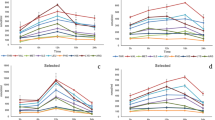Abstract
Hatching and start-feeding temperatures affected the expression of different trypsin isozymes in the pyloric caeca of Atlantic salmon. Hatching temperature of 10 °C induced the expression of the common isozyme TRP-2*100, and of 6 °C induced the variant TRP-2*92 (p$<$0.01). In contrast, start-feeding temperature of 12 °C significantly (p$<$0.0001) influenced the expression of the variant TRP-2*92, compared to 6 °C. The frequencies between different trypsin isozyme patterns were not changed at later stages under varied rearing temperatures.
The frequency distribution between Atlantic salmon without and with trypsin variants was about 0.4:0.6. The trypsin isozyme TRP-2*92 was the major variant in Norwegian salmon, while the trypsin variant TRP-1*91 was dominant in Scottish salmon, at frequencies of 0.47 and 0.42, respectively. The presence of both the common and either variant trypsin isozymes were important for feed utilization and growth at varying rearing temperatures. Trypsin isozymes are functionally sensitive to different temperatures. The expression of the common trypsin isozyme TRP-2*100 is important when the water temperature is $>$ 8 °C, while it is important for the expression of the variant TRP-2*92 when the water temperature is $\leq$ 8 °C, especially below 6 °C. The variant TRP-1*91 was observed to perform effectively at a wider temperature range than the variant TRP-2*92, but not at temperature $\leq$ 6 °C.
Genetic variation in trypsin isozyme pattern is a primary factor affecting food conversion efficiency and growth under different rearing temperatures.
Similar content being viewed by others
References
Austreng, E., Storebakken, T. and Åsgård, T. 1987. Growth rate estimates for cultured Atlantic salmon and rainbow trout. Aquaculture 60: 157-160.
Bassompierre, M., Ostenfeld, T. H., McLean, E. and Rungruangsak-Torrissen, K. 1998. In vitro protein digestion, and growth of Atlantic salmon with different trypsin isozymes. Aquacult. Int. 6: 47-56.
Carter, C. G., Houlihan, D. F., Buchanan, B. and Mitchell, A. I. 1993. Protein-nitrogen flux and protein growth efficiency of individual Atlantic salmon (Salmo salar L.). Fish Physiol. Biochem. 12: 305-315.
Carter, C. G., Houlihan, D. F., Buchanan, B. and Mitchell, A. I. 1994. Growth and feed utilization efficiencies of seawater Atlantic salmon, Salmo salar L., fed a diet containing supplementary enzymes. Aquacult. Fish. Managem. 25: 37-46.
Gall, G. A. E. 1993. Genetic change in hatchery populations. In Genetic Conservation of Salmonid Fishes. pp. 81-91. Edited by J.G. Cloud and G.H. Thorgaard. NATO Advanced Science Institutes Series, Plenum Press, New York.
Levings, C. D. 1993. Requirements for genetic data on adaptations to environment and habitats of salmonids. In Genetic Conservation of Salmonid Fishes. pp. 49-66. Edited by J. G. Cloud and G. H. Thorgaard. NATO Advanced Science Institutes Series, Plenum Press, New York.
Ricker, W. E. 1979. Growth rates and models. In Fish Physiology. Vol. 8, pp. 677-743. Edited by W. S. Hoar, D. J. Randall and J. R. Brett. Academic Press, New York.
Robinson, B. W. and Doyle, R. W. 1990. Phenotypic correlations among behavior and growth variables in tilapia: implications for domestication selection. Aquaculture 85: 177-186.
Torrissen, K. R. 1984. Characterization of proteases in the digestive tract of Atlantic salmon (Salmo salar) in comparison with Rainbow trout (Salmo gairdneri). Comp. Biochem. Physiol. 77B: 669-674.
Torrissen, K. R. 1987. Genetic variation of trypsin-like isozymes correlated to fish size of Atlantic salmon (Salmo salar). Aquaculture 62: 1-10.
Torrissen, K. R. 1991. Genetic variation in growth rate of Atlantic salmon with different trypsin-like isozyme patterns. Aquaculture 93: 299-312.
Torrissen, K. R., Lied, E. and Espe, M. 1994. Differences in digestion and absorption of dietary protein in Atlantic salmon (Salmo salar) with genetically different trypsin isozymes. J. Fish Biol. 45: 1087-1104.
Torrissen, K. R., Lied, E. and Espe, M. 1995. Differences in utilization of dietary proteins with varying degrees of partial prehydrolysis in Atlantic salmon (Salmo salar L.) with genetically different trypsin isozymes. In Biopolymers and Bioproducts: Structure, Function and Applications. pp. 432-442. Edited by J. Svasti, V. Rimphanitchayakit, A. Tassanakajorn, P. Pongsawasdi, B. Sonthayanon, K. Packdibamrung, S. Soontaros, T. Limpaseni, P. Wilairat, J. Boonjawat and S. Kamolsiripichaiporn. Proc. 11th FAOBMB Symp., Samakkhisan Public Company Limited, Bangkok.
Torrissen, K. R., Male, R. and Nævdal, G. 1993. Trypsin isozymes in Atlantic salmon, Salmo salar L.: studies of heredity, egg quality and effect on growth of three different populations. Aquacult. Fish. Managem. 24: 407-415.
Torrissen, K. R. and Shearer, K. D. 1992. Protein digestion, growth and food conversion in Atlantic salmon and Arctic charr with different trypsin-like isozyme patterns. J. Fish Biol. 41: 409-415.
Torrissen, K. R. and Torrissen, O. J. 1985. Protease activity and carotenoid levels during the sexual maturation of Atlantic salmon (Salmo salar). Aquaculture 50: 113-122.
Author information
Authors and Affiliations
Rights and permissions
About this article
Cite this article
Rungruangsak-Torrissen, K., Pringle, G.M., Moss, R. et al. Effects of varying rearing temperatures on expression of different trypsin isozymes, feed conversion efficiency and growth in Atlantic salmon (shape Salmo salar L.). Fish Physiology and Biochemistry 19, 247–255 (1998). https://doi.org/10.1023/A:1007731717021
Issue Date:
DOI: https://doi.org/10.1023/A:1007731717021




